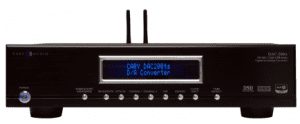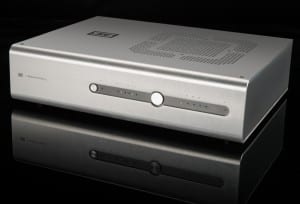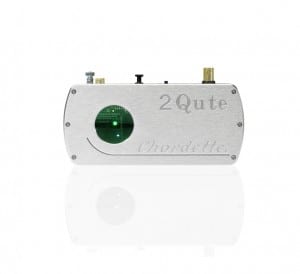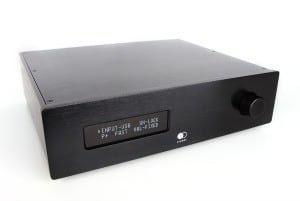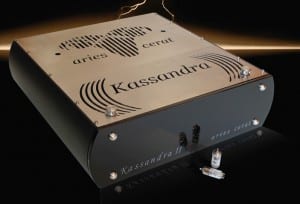I like Schiit’s attitude to their products and confess to using their entry level (£90 per box) Modi USB DAC and Magni headphone amp when listening none critically on my normal work desktop system. They’re made in the USA, well made, attractive and offer very good value for money to my mind, and despite their name they have a solid history in the audio world – Jason Stoddard and Mike Moffat designed numerous well known products for Sumo before branching out on their own to launch Schiit. The entry level kit comes with a two year warranty, but the more expensive kit, like we’re looking at heer, comes with an impressive five year warranty. I also like th![bifrost_06]() eir marketing spiel “Because you’re an audiophile does not have to mean “born with a stick up your ass””.
eir marketing spiel “Because you’re an audiophile does not have to mean “born with a stick up your ass””.
Here we have on test the Lyr 2 headphone amplifier and the Bifrost (with full blown USB 2 receiver) DAC which retail in the UK for £340 and £395. Both the units are substantially bigger than their entry level siblings, but still a good deal smaller than conventional hi-fi boxes and suitable for use on a desktop – they each measure 9 x 6 x 3.25 inches. All the bits and bobs in the boxes are surface mounted with the aim here being to keep prices down to affordable levels. The units are finished in brushed aluminium and look really rather nice I think.
Lyr 2
Lyr 2 is a high powered headphone amp offering up 6W into 32 ohms to 330mW into 600 making it ![LY2_1]() suitable for just about any headphone you’d care to throw at it. In the box you get the attractive and distinctive Lyr 2 itself, a power cable, some little stick on feet and a pair of 6B7Zvalves – the Lyr 2 can use any 6Dj8, 6922, ECC88, 6N23P and 6Bz7 tubes so that tube rollers can play to their hearts content, though I decided to stick with the stock Russian tubes in the box. The Lyr 2 uses a “Dynamically Adaptive Output Stage” which the company says is a “current sensing adaptive output technology which allows the amplifier to dynamically adjust to the headphone load. The Primary benefits are essentially single-ended Class A output for high-impedence headphones, moving seamlessly to push-pull Class A and finally into Class AB as current needs increase”.
suitable for just about any headphone you’d care to throw at it. In the box you get the attractive and distinctive Lyr 2 itself, a power cable, some little stick on feet and a pair of 6B7Zvalves – the Lyr 2 can use any 6Dj8, 6922, ECC88, 6N23P and 6Bz7 tubes so that tube rollers can play to their hearts content, though I decided to stick with the stock Russian tubes in the box. The Lyr 2 uses a “Dynamically Adaptive Output Stage” which the company says is a “current sensing adaptive output technology which allows the amplifier to dynamically adjust to the headphone load. The Primary benefits are essentially single-ended Class A output for high-impedence headphones, moving seamlessly to push-pull Class A and finally into Class AB as current needs increase”.
Set up is a simple case of inserting the valves, plugging in the IEC, turning the amp on and then connecting to a suitable source via the input RCAs. Also around the back is a pair of RCA outlets (turned off when you plug in headphones) allowing you to connect to a power ![LYR2-2]() amplifier of your choice. You also get a gain setting switch for efficient or less efficient headphones and an on/off toggle switch. Move round the front and you have an LED to let you know the unit is powered up, a volume pot, a quarter inch headphone jack… and that’s your lot.
amplifier of your choice. You also get a gain setting switch for efficient or less efficient headphones and an on/off toggle switch. Move round the front and you have an LED to let you know the unit is powered up, a volume pot, a quarter inch headphone jack… and that’s your lot.
The Lyr 2 has a few “upgrades” over its predecessor including a regulated 180V power supply for the valve stage, separate regulated power supplies for the current sources and DC Servo and regulated supplies for the DC heaters.
Bifrost
The USB input on this Bifrost uses C-Media CM6631 USB receiver interface and asynchronous data transfer of up to 24/192, but you also get the option to input via coaxial or optical. The D/A chip is an AKM4399 and rather than upsampling the Bifrost keeps samples at their original rate using adaptive master clock management system.
Round the back of the Bifrost you have the IEC power in, a power switch toggle, inputs for USB, Optical and SPDIF coaxial and a pair of RCA outputs to connect to your preamplifier. On the front you’ve got a button to cycle through the input selections and three LEDs to let you know what input you have selected.![OUTSTANDING PRODUCT150]()
Set up is a simple affair of downloading the Windows drivers, plugging in your input cables and connecting to your preamp/amp. J Player recognised the drivers and the Bifrost itself immediately and the whole set up procedure took no more than three or four minutes.
I’m moving over to a computer based system and so most of the listening will be done using the USB input using JRiver as the player, with some listening using the coaxial output from a pioneer DVD. Headphones used will be Audeze LCD –XC and when using the Lyr 2 as a preamplifier it will be fed into a TQ Iridium power amplifier.
Lyr 2 and Bifrost Paired Using Headphones
The first album off the virtual shelf was the excellent 2 Future 4 U by Amand Van Helden, a slab of funky beats and deep![bifrost]() bass which comes across here as nicely timed with snappy beats and a coherency across the frequency ranges that was really rather pleasing. There’s punch to the sound but with no frequency range really dominating. I’ve been testing headphones and headphone amps out a lot over the last couple of months and it’s to the pairing’s credit that I didn’t really miss the reference VAD DAC and my reference headphone amplifier on this type of music. Switching to the Tresor 109 compilation it’s really hard to fault what the pairing is doing for just over £700. There’s good separation of instruments in the mix, which is thrown wide and is stable. The combination give a slightly more analogue feel to the sound than I’ve encountered with some headphone/DAC combos. The slight softening of the sound will appeal to a good few and make the transition from an analogue front end to an all digital set up much more acceptable. This is not to suggest that the sound here is mushy or compromised, it’s not, it’s just not got that slight harshness at the frequency extremes that you can sometimes get with some DACs.
bass which comes across here as nicely timed with snappy beats and a coherency across the frequency ranges that was really rather pleasing. There’s punch to the sound but with no frequency range really dominating. I’ve been testing headphones and headphone amps out a lot over the last couple of months and it’s to the pairing’s credit that I didn’t really miss the reference VAD DAC and my reference headphone amplifier on this type of music. Switching to the Tresor 109 compilation it’s really hard to fault what the pairing is doing for just over £700. There’s good separation of instruments in the mix, which is thrown wide and is stable. The combination give a slightly more analogue feel to the sound than I’ve encountered with some headphone/DAC combos. The slight softening of the sound will appeal to a good few and make the transition from an analogue front end to an all digital set up much more acceptable. This is not to suggest that the sound here is mushy or compromised, it’s not, it’s just not got that slight harshness at the frequency extremes that you can sometimes get with some DACs.
On Fleetwood Mac’s Songbird track there is a good sense of the recording space with the natural reverb on the piano being large and natural sounding, another area that can leave some cheaper DACs found wanting. In this area the Bifrost/Lyr 2 combo really do rather well when compared to the reference DAC and headphone amp, though there is a feeling of there being more spatial information being apparent with the, it has to be said, much more expe![bifrost_05(1)]() nsive references. This is evident also on Gil Shaham’s 1930’s Violin Concertos where it’s pretty easy to get a good sense of the orchestra in front of you and the recording space, but not as deep an insight as I’m used to. Could I live with it…well I suppose it’s like anything isn’t it, if you’ve heard something you consider to be the best then it’s hard to move down the listening ladder, but for those with 700 quid to splash, then I reckon you’d be hard pushed to beat this duo when used with headphones.
nsive references. This is evident also on Gil Shaham’s 1930’s Violin Concertos where it’s pretty easy to get a good sense of the orchestra in front of you and the recording space, but not as deep an insight as I’m used to. Could I live with it…well I suppose it’s like anything isn’t it, if you’ve heard something you consider to be the best then it’s hard to move down the listening ladder, but for those with 700 quid to splash, then I reckon you’d be hard pushed to beat this duo when used with headphones.
On female vocals such as Kathryn William’s Crown Electric and Mary Black’s Best Of albums there’s a silky smooth quality that is really addictive. Again there’s a feeling of a slight softening, or warming to the sound in the mid frequencies that I really enjoyed with this kind of music. The combo will be popular with those that listen to the stereotypical audiophile recordings that prevail at shows, but that’s not to say that the Shiit coupling can’t rock out as proved on Pixie’s Doolittle where there’s enough power and oomph to satisfy, with that non-analytical feel to the sound that actually makes the combo really easy to listen to for long periods of time.
Lyr 2 in the Main Rig
Popping the Lyr 2 into the main system and using it as a preamplifier was a pleasant if not overwhelming experience, but then the pre it was replacing is the Coffman G1-A costing several thousands of dollars.
The soundstage is good, wide and deep with an ever so slight feeling that things are being slightly exaggerated. Instruments remain nice and stable and you get a good idea of where they are seated in the mix.
This is an easy to listen to preamplifier with the slight warming effect I noted previously and it has to be said that it performs very well for the money Schiit are asking you to pay. There’s reasonable amounts of detail coming through when compared to the reference and there’s good tonality…erring on the side of smoothness. In reality there’s little really to criticise, but the Lyr 2 is a little out of its depth here, leaving me with a feeling that I’m not connecting with the music in the same way I would normally with the main pre in place. Sadly I don’t have an entry level power amplifier in the house at the moment and so couldn’t test the Lyr 2 in a setting it may be reasonably used in, but given its performance so far I’d say it would be a very decent choice for the money.
Plug in the headphones and the output to the main amp is cut. There’s a sense that you are getting a reasonable deal of the VAD DAC’s character, with the Lyr doing that slight softening thing again, particularly in the mid-band. However, when compared to the Beyerdynamic A20 headphone amplifier costing around £400 and in the same system it performs well, with the Schiit perhaps being more to my taste when listening to cans.
The Lyr drove all the cans I threw at it to loud volumes and with the Audeze headphones plugged in I found that going anywhere past 9 o clock was too loud. I note here that the Lyr 2 does get very hot indeed and so this needs to be a consideration when placing it on your rack.
Bifrost in the Main Rig
Again this is a bit of an unfair ask given the pricepoint of the Schiit DAC, but all in all it performed very well indeed. On Madonna’s MDNA album there’s a terrific drive to the sound, particularly in the lower frequencies and the play between drum tracks and basslines. There’s a real feeling of pace and overall a big sound that is sure to bring a smile to your face.
On more laidback tracks such as The Rolling Stone’s Lady Jane, there’s a warmness of the sound overall, particularly mids, but the plucked strings still manage to sound fast, precise and sparkly. Actually there’s an addictiveness to this little DAC that belies its asking price. No, it doesn’t have the overall finesse and poise of our reference, but it certainly does a very admirable job of connecting you with the music.
I’ve mentioned warmness quite a bit in the review of these two products, but I’d suggest that the Lyr 2 is responsible for the majority of this. The DAC is pretty well defined with a relatively transparent sound. Soundstaging is pleasing and at the top end of the frequency scale hats sparkle nicely with good decay, whilst at the lower end of things there’s good weight and punch. Mids are an area that I’d say are a little on the warmer side of neutral, but as a whole this warmness in this frequency band brings an ease to the listening experience that I really enjoyed. There is good layering and separation of instruments in the mix
Conclusion
The Schitt kit reviewed here offers great value for money and at the price point they offer a very high level of sound that most will fail to achieve. They are certainly a step up from many of the products I’ve heard at a similar price.
As a pairing when used as a desktop system for listening via headphones they are really very good indeed and despite being quite big for a workspace, they do look attractive and sound great.
As separate entities and for use in a main system, I have no qualms in heartily recommending each of the Schiit products reviewed here and they do punch well above their weight, but I would suggest that they are both best suited to ancillary equipment that is of a more relevant performance point.
Stuart Smith
Lyr 2 ![RECOMMENDED LOGO NEW]()
Build Quality – 8.5/10
Sound Quality – 8.25/10
Value For Money – 8.75/10
Overall – 8.5/10
Price at time of review – £340
Bifrost![OUTSTANDING PRODUCTboxred]()
Build Quality – 8.5/10
Sound Quality – 8.65/10
Value For Money – 8.9/10
Overall – 8.68/10
Price at time of review – £395
Both these products are recommended as offering no-nonsense solutions that offer good sound for a very reasonable asking price.
The Bifrost will now go though for second review with Janine Elliot and the chance to gain an Outstanding Product Award.
Having done some PR/advisory work with Tacima mains cables/conditioners, and suggested the name sounded a bit, well, ‘Tacky’, they then changed the name to Kauden, which sounded like something you find in a cow shed. So after I got over laughing at the different paraphrases associated with Schiit Audio (there is also a British speaker company called Dyer Audio, the list just goes on!) I just got on with reviewing this DAC, and also putting it alongside the totally different Slee DAC reviewed last month. Actually, whilst the other names were unfortunate, Schiit audio was named that way quite simply to get attention. And no, the company is not German, but designed and built in America, founded by two audiophiles, Jason Stoddard (ex Sumo) and Mike Moffat (ex Theta) and not sold at extortionate Class A prices, like most American built obesities. This is a healthy size 6 yet still with the oomph and energy associated with more expensive products from across the pond. As they say on their website, they are dead serious about audio, and boy is this more than its reserved dimensions would suggest.
The Schiit Bifrost is a 24/192 SPDIF and Toslink DAC with option for 24/192 capable USB input with the USB Gen 2 upgrade and improved electronics in the Uber Bi Frost add-on, all for a total of £410 (up a tad from the time of Stuart’s review). It was this complete version that I review here. Unlike the Slee Majestic DAC I reviewed recently, with only 24bit/48kHz USB input and balanced output and the benefit of its own volume control, the much cheaper Schiit has RCA line outputs for connection to an integrated amp or pre-amp. Connected to my Passive MFA Baby Reference ensured there were no added sound-prints on the way to the speakers, and through my obese Krell monolith and Townshend SuperTweeter and Torus subsonic generator would ensure all frequencies would get to my speakers unadulterated and with all the energy they deserve. Unlike the Slee, the Schiit is future proof, with separate upgradeable USB input and DAC/analog cards, and as stated above comes in a variety of versions with or without USB. Ok so far.
Schiit pricing is amazingly good, starting with their $99 Modi 2 USB DAC, cheaper than the £99 Cambridge Audio USB equivalent, though not so petite. Indeed, their ethos of pricing to meet the mass market is something new and welcome in the rapidly changing market place. The design is equally simplistic in its use of a single switch toggling between the three sources indicated with white LEDs and with a simple RCA output. There are cheaper and more exciting looking units out there, but the finish is by no means cheap in appearance. What is welcoming, and something I expect to see in all high-grade HiFi, is that the components are full discrete designs (whether you choose standard or Uber versions), and assembled in such a way that they can be manufactured at a price point to compete with cheap Chinese built products. With the Uber analogue stage you get the more advanced Gungnir DAC and a DC servo which eliminates the need for capacitors in the signal path. This all has an effect on the sound I heard. There were no crinkly top frequencies; rather they were as crisp as the Roast Duck I cooked over Christmas. All frequencies had a clarity and power that I would expect in higher price kit. Connected to my S/PDIF CD player output, Pictures at an Exhibition ‘The Hut of Baba-Yaga’ (Minnesota orchestra) had clear definition between each instrument with respect to position and a clear ‘space’ between the instruments, and music was calm and in control, unlike many DACs and CD players I have put this through. Wynton Marsalis ‘New Orleans Bump’ had a very clear musical spread, My Krell KPS20i was in another league in terms of detail and musicality, but the Schiit put on a very good show. Spring can Really Hang You Up the Most (Rickie Lee Jones) bass was more forward than through my CD player though lacked the deepest frequencies that the Krell CD gives with such authority. The snare in ‘Walking to the Moon’ (The Yuri Honing Trio) wasn’t so clearly defined, in terms of natural sound decay, but not so exciting and ‘life-like’ as I would like it. Putting away my aged CD player and joining the 21st Century, using Foobar2000 I played 24bit/192kHz digital files from my growing collection. The bass had bite, cymbals had clout and metal rock didn’t sound like aluminium. This was a surprisingly powerful piece of kit, not over the top but ‘tight’ and with authority, and most importantly, musicality. All instruments had a clearly defined soundstage in ‘Secret Love’, as did complicated orchestration of percussion and piano in ‘The Man Who Sold the World’, both from Claire Martin(Linn) all from Linn’s kind 24bits of Christmas present to all 24/192 fans this December (well worth a download). This worked clearer than many DACs I have tried over the last few years; which often sounded fuzzy or ‘digital’ with unclear soundstage. However, once I got into mid frequencies the clarity, composure and delicacy of sound wasn’t quite as good as the best out there. For example in the brilliant Requiem in D from Mozart K626 (Linn) was surprisingly less clear in the violins than it was through the 24/48kHz Slee Majestic, as was the slow Elgar Enigma Variation No 9. (Lawrence Foster.Houston Symphony Orchestra). This DAC was better at playing more exciting and easy-to-differentiate sounds, than those that perhaps require a more musical musician’s ear. Maybe more technical specification doesn’t necessarily mean more musicality, and something maybe needing a very slight tweak in the analogue section. However, I do not want to sound like I am at all putting down this machine. In terms of detail and crispness of sound per pound (or dollar), this is a stonker of a machine. I could hear compression and limiting in some of the tracks I played, which I didn’t hear in other similarly priced DACs, but I believe this was more of the recording getting to my speakers rather than any fault in the equipment. Nothing was getting passed this machine un-noticed. With no sample-rate conversion, all data is processed at its native rate, which is something I am always in favour of. Unlike the Slee, the muting circuitry came alive every time a track was followed by another one at a different resolution, preventing those horrible clicks through my speakers. This would play all sources I put at it, though I never got to try 24/192kHz through the Toslink, which was never designed for anything greater than 96kHz. DSD sources still wouldn’t work, but this is something Schiit looked into doing in 2012 and after asking consumer opinion came out with the Loki. This is Schiit at its best; not frightened to attempt anything, and making sure it works. Just wish they’d allow HD sound from my Virgin Tivo box. Only ITV1 HD works.
The Uber audio specification is a very respectable 2-100,000Hz (-1dB) with a maximum S/N ratio of 110dB. Whilst another 34dB is theoretical though not possible today with 24bits, and my favoured Brüel & Kjær 4138 microphone has a dynamic range of up to 168 dB and hears from 6.5 Hz to 140 kHz, as a sound engineer I don’t think we have yet reached the end of our search for the perfect sound systems, though I stress again, musicality is not just down to numbers. The Schiit deciphers the digits brilliantly in terms of detail, but just misses out in its analogue stage to stop me giving a really high sound quality number. But I know that Schiit will never stop searching for audio nirvana, and their overbuilt modular approach to design will mean they will always be up to date and “won’t end up in the dumpster”, and be something so well built that they are intended to be “passed down to your children”. I’ll say it here, though, I’m not letting my kids near my Hi-Fi. Period.
Conclusion This is a serious piece of kit for the price and well worth a listen to if you want to spend anything sub £1000. It has a depth of detail that is hard to beat at it’s price, only slightly losing out on musicality. But for that, you need to pay much more.![OUTSTANDING PRODUCT150]()
Sound Quality – 8.55/10
Value for Money – 8.8/10
Build Quality – 8.5/10
Overall – 8.62/10
Janine Elliot
Read more hifi reviews
How we carry out reviews.
Read more Hifi Review.
![Share]()
 QuteEX – a 384kHz PCM/DSD 128 device compatible with high-resolution DXD (Digital eXtreme Definition) music files. The QuteEX is an upgraded version of Chord Electronics’ QuteHD and has been available alongside the QuteHD since the EX’s introduction in October, offering the option of decoding at up to 384kHz PCM and DSD 128 over USB, against the QuteHD’s 192kHz PCM and DSD 64.
QuteEX – a 384kHz PCM/DSD 128 device compatible with high-resolution DXD (Digital eXtreme Definition) music files. The QuteEX is an upgraded version of Chord Electronics’ QuteHD and has been available alongside the QuteHD since the EX’s introduction in October, offering the option of decoding at up to 384kHz PCM and DSD 128 over USB, against the QuteHD’s 192kHz PCM and DSD 64.

 eir marketing spiel “Because you’re an audiophile does not have to mean “born with a stick up your ass””.
eir marketing spiel “Because you’re an audiophile does not have to mean “born with a stick up your ass””.
 amplifier of your choice. You also get a gain setting switch for efficient or less efficient headphones and an on/off toggle switch. Move round the front and you have an LED to let you know the unit is powered up, a volume pot, a quarter inch headphone jack… and that’s your lot.
amplifier of your choice. You also get a gain setting switch for efficient or less efficient headphones and an on/off toggle switch. Move round the front and you have an LED to let you know the unit is powered up, a volume pot, a quarter inch headphone jack… and that’s your lot.
 bass which comes across here as nicely timed with snappy beats and a coherency across the frequency ranges that was really rather pleasing. There’s punch to the sound but with no frequency range really dominating. I’ve been testing headphones and headphone amps out a lot over the last couple of months and it’s to the pairing’s credit that I didn’t really miss the reference VAD DAC and my reference headphone amplifier on this type of music. Switching to the Tresor 109 compilation it’s really hard to fault what the pairing is doing for just over £700. There’s good separation of instruments in the mix, which is thrown wide and is stable. The combination give a slightly more analogue feel to the sound than I’ve encountered with some headphone/DAC combos. The slight softening of the sound will appeal to a good few and make the transition from an analogue front end to an all digital set up much more acceptable. This is not to suggest that the sound here is mushy or compromised, it’s not, it’s just not got that slight harshness at the frequency extremes that you can sometimes get with some DACs.
bass which comes across here as nicely timed with snappy beats and a coherency across the frequency ranges that was really rather pleasing. There’s punch to the sound but with no frequency range really dominating. I’ve been testing headphones and headphone amps out a lot over the last couple of months and it’s to the pairing’s credit that I didn’t really miss the reference VAD DAC and my reference headphone amplifier on this type of music. Switching to the Tresor 109 compilation it’s really hard to fault what the pairing is doing for just over £700. There’s good separation of instruments in the mix, which is thrown wide and is stable. The combination give a slightly more analogue feel to the sound than I’ve encountered with some headphone/DAC combos. The slight softening of the sound will appeal to a good few and make the transition from an analogue front end to an all digital set up much more acceptable. This is not to suggest that the sound here is mushy or compromised, it’s not, it’s just not got that slight harshness at the frequency extremes that you can sometimes get with some DACs. nsive references. This is evident also on Gil Shaham’s 1930’s Violin Concertos where it’s pretty easy to get a good sense of the orchestra in front of you and the recording space, but not as deep an insight as I’m used to. Could I live with it…well I suppose it’s like anything isn’t it, if you’ve heard something you consider to be the best then it’s hard to move down the listening ladder, but for those with 700 quid to splash, then I reckon you’d be hard pushed to beat this duo when used with headphones.
nsive references. This is evident also on Gil Shaham’s 1930’s Violin Concertos where it’s pretty easy to get a good sense of the orchestra in front of you and the recording space, but not as deep an insight as I’m used to. Could I live with it…well I suppose it’s like anything isn’t it, if you’ve heard something you consider to be the best then it’s hard to move down the listening ladder, but for those with 700 quid to splash, then I reckon you’d be hard pushed to beat this duo when used with headphones.























